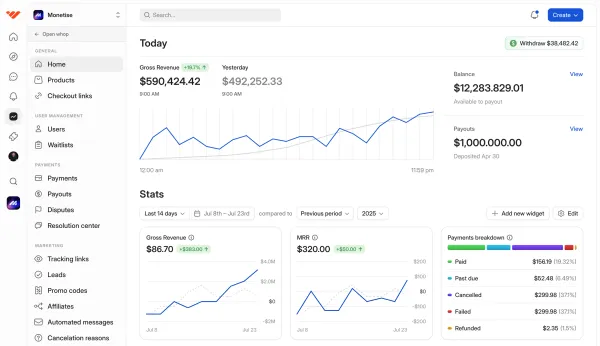Key takeaways * Product adoption rate equals new continuous users divided by new sign-ups times 100. * Monthly active users provide more accurate adoption insights than daily active users. * Feature adoption rate reveals which specific features struggle with user engagement. * Time to value measures how quickly customers reach their activation milestone. * Customer
Key takeaways
- Product adoption rate equals new continuous users divided by new sign-ups times 100.
- Monthly active users provide more accurate adoption insights than daily active users.
- Feature adoption rate reveals which specific features struggle with user engagement.
- Time to value measures how quickly customers reach their activation milestone.
- Customer engagement score combines weighted events to predict user retention and churn.
So, you’ve got your SaaS products up for sale, and you feel that your business is on the right track. But are you sure of that? Have you noticed that you aren’t getting as many active users for your product as you were expecting? Maybe you just want to know how your product is being viewed by your customers. Whatever your goals, measuring SaaS adoption is a necessary part of running a successful Software-as-a-Service business.
In this article, we’re going to give you a comprehensive overview of five impactful SaaS adoption metrics that you can use to measure your product’s success.
Calculating your SaaS product adoption rate
First of all, you need to know how to calculate your SaaS product adoption rate. This rate will tell you the percentage of customers who are continuing to use your product after signing up.
Here’s the formula: (New Continuous Users / New Sign-Ups) * 100
This formula will only make sense if you choose a specific period for the calculation. The most common choice is to analyze the product adoption rate for the last month.
To illustrate, let’s say you had 30 new sign-ups in May. At the end of that month, 24 of those sign-ups are what you would call continuous users. To calculate your product adoption rate for May, the formula would look like this: (24/30) * 100 = 80%. Whew, that’s a pretty nice rate!
While it may seem like this is the all-important metric for measuring SaaS adoption, it is just one measurement. The truly vital metrics are those that can tell you why your customers like or dislike your product, and provide insights into the details of how users are interacting with your product.
Read: What is Product Adoption and How Do You Measure It?
5 Metrics for measuring SaaS adoption
Once you know how to calculate your product adoption rate, you can look at other, more specific metrics to figure out why the rate is what it is, and how you might improve it. Let’s take a look at five impressive metrics that you can use to measure SaaS adoption.
#1 - Active users
In SaaS, active users are defined as those customers who actively interact with your product over a given time. This is a specific way to measure the number of users that use your product regularly–in other words, it measures your current, average SaaS adoption.
The active users metric is most commonly broken down into daily active users (DAU) and monthly active users (MAU). There are two ways to measure this. One is to simply use the number of active users. The other option, which is more effective for measuring SaaS adoption, is to calculate the percentage of active users. We’re going to discuss the latter.
Daily Active Users (DAU)
Here is the formula for calculating the percentage of DAUs: (DAUs / Total # of Users) * 100
The first step in making this calculation is to determine the number of daily active users of your product. Choose a day, count the number of active users, and then divide that number by the total number of users. Then, multiply that result by 100 to get the percentage. This percentage tells you how many of your daily users are adopting and using your product compared to those who might have been interested at the start but lost interest.
Example: Say you have 50 DAUs and 200 users. Your DAU percentage would be (50/200) * 100 = 25%.
Monthly Active Users (MAU)
Calculating the percentage of monthly active users is generally going to give you a more accurate result of the kind of SaaS adoption your product truly has. This is because users may not be using your product every day, so, with the MAU percentage, you will end up with an average.
Here is the formula: (MAUs / Total # of Users) * 100
As with calculating the DAU percentage, this formula requires you to count the number of active users you have in a given month, and then divide that number by the total number of users. Multiply the result by 100 to make this a percentage.
Example: Imagine you have 150 MAUs and 200 users. Your MAU percentage would be (150/200) * 100 = 75%.
Both the DAU percentage example and this MAU example could be realistic percentages for the same product and business. This is because of what we mentioned above about how users may not be using your product daily, but still are actively adopting it.
#2 - Feature adoption rate
The feature adoption rate metric is used to measure the percentage of users who adopt a new, core, or advanced feature of your product. It is similar to the overall product adoption rate, but it gives you more specific insights into individual features. Essentially, this rate can tell you if users are having a hard time using a specific feature, or if you can rework a feature to make it fit better with your customers’ needs.
This is the formula for calculating your feature adoption rate: (# of New Feature Users / Total # of Users) * 100
Before you can calculate this, you need to decide which of these three types of features you are analyzing:
- New: percentage of users that adopt a new feature
- Core: percentage of users that adopt a core feature
- Advanced: percentage of users that adopt a technically advanced feature
Each will tell you something different about your customers and your product, but the same formula can be used for all.
Example: You have added a new feature to your product to make it easier to save the user’s progress. At the end of June, you have 15 new feature users and 50 total users. Your feature adoption rate would be (15/50) * 100 = 30%. This tells you that the new feature might not be easy to use or readily available to customers.
#3 - Time To Value (TTV)
The time to value (TTV) metric is a little different than what we’ve previously mentioned. This metric measures the time it takes for customers to reach the “aha moment” and fully adopt your SaaS product. It can tell you whether your product is easily understood or useful to users by showing you how long it takes for them to become committed to it. The shorter the TTV, the better.
Here’s the TTV formula: Date (or Time) of Final Activation Milestone - Date (or Time) of Initial Sign-Up
To make this formula work, you need to decide on what makes a user an adopter. This could be anything from the time when a customer starts using your product twice a week to the moment when they start using a unique feature. You decide what that “aha moment” means for your product and then stick to it consistently so that the TTV formula makes sense.
Example: What if you have a user sign up at 10:00 AM on Friday, then reach the activation milestone at 5:00 PM on the same day? That user’s TTV would be 5:00 PM - 10:00 AM = 7 Hours.
#4 - Activation rate
Another way to measure SaaS adoption is to calculate the user activation rate. This is closely tied to the previous metric. Simply put, the activation rate measures the percentage of users who reached the activation milestone versus the total number of those who signed up. This rate can tell you if your product is truly useful to your customers.
The formula for calculating the activation rate is as follows: (# of Users Who Reached the Activation Milestone / Total # of Users Who Signed Up) * 100
As with the TTV metric, you need to decide on your product’s activation milestone before you can calculate the activation rate. Every product will have a different indicator, and you need to choose what this means for yours. Additionally, like all metrics, you need to put this into a timeframe, such as measuring last month’s activation rate.
Example: Your product has 40 users who reached the activation milestone and 500 total users who signed up over the last month. Your activation rate is (40/500) * 100 = 8%. That’s a low rate! It’s time to reconsider how you can make your customers see your product’s value.
#5 - Customer Engagement Score (CES)
The fifth metric is the customer engagement score (CES). This one can tell you a lot about your product and can provide insight into areas for improvement. At its heart, CES measures how your users feel about your product and whether they find real value in it.
A customer with a high CES means they love your product, and one with a low CES doesn’t care for your product and could churn. When you know the factors behind a high CES, you can use that to improve your SaaS adoption rate.
This is the CES formula: (e1 * n1) + (e2 * n2) + … + (e# + n#)
That probably makes no sense to you. Let us explain. In the formula above, “e” represents an engagement event, and “n” is the number of times the event happened. When you calculate a CES, you need to determine the actions your users must take that contribute to product engagement. Once you’ve made a list of these actions, you will assign a value to each between 1 and 10, depending on its importance. This is the “e” in the formula. Now, you can use the formula to calculate a user’s CES.

Example: You have three events at the values of 5, 8, and 10, respectively. User A has performed these events 3, 5, and 2 times, respectively. User A’s CES is (5 * 3) + (8 * 5) + (10 * 2) = 75.
Read next: Product Adoption Metrics Your Business Should be Tracking
Boost your SaaS adoption rate
Now that you know some of the impactful metrics for measuring SaaS adoption, you probably want to know how to boost those metrics and get your product adopted by thousands. Have you considered selling your SaaS products on the Whop marketplace?
👉 With Whop, you can quickly put your SaaS products in front of thousands of eyes, and measure your SaaS adoption rate with over 18 stats and insights. Start selling on Whop today!
📚 Read next: SaaS Metrics That Matter



